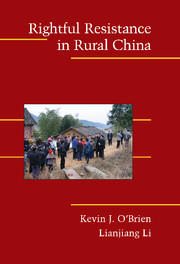Book contents
Preface
Published online by Cambridge University Press: 05 September 2012
Summary
We first noticed rightful resistance in the summer of 1994, when we were doing fieldwork on village elections in China. As officials and researchers in Shandong, Hebei, and Hubei described the problems rural leaders faced, they told us fascinating stories about “nail-like individuals” (dingzihu) and “shrewd and unruly people” (diaomin). We soon learned that villagers whom cadres labeled this way were often responsible for launching protests, including actions as small as trying to topple a village leader and as large as organizing an antitax demonstration that drew in thousands of farmers. That first summer, despite some promising interviews, we were not overly hopeful that we could discover a great deal about these people or what they did. After all, rural unrest was (and still is) a sensitive topic in China, on which sources were scarce, anecdotes rare, and fieldwork fraught with complications.
We returned home and started reading. Our initial search for examples of protests did not turn up much, although we did locate some informative articles in out-of-the-way Chinese journals and popular magazines. Still, we felt unsure what to make of these accounts, mainly because we did not have any complete cases that were as detailed as we needed.
This changed when we gained access to our first full episode of rural contention, in which dozens of villagers were struggling to oust a local Communist Party secretary who they were confident was corrupt.
- Type
- Chapter
- Information
- Rightful Resistance in Rural China , pp. xi - xviiiPublisher: Cambridge University PressPrint publication year: 2006

